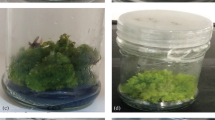Summary
The protoplasts ofNicotiana plumbaginifolia required darkness for cell regeneration and colony formation. Maximal plating efficiency of the protoplasts could be achieved by keeping the cultures in dark instead of light or dark/light sequence. Only two days of darkness prior to the illumination at 400 or 3,000 lux resulted in appreciable plating efficiency, than those of light from the beginning, but these values could not match the high plating efficiency in total darkness.
Similar content being viewed by others
References
Banks, M. S., Evans, P. K., 1976: A comparison of the isolation and culture of mesophyll protoplasts from severalNicotiana species and their hybrids. Plant Sci. Lett.7, 409–416.
Durand, J., Potrykus, I., Donn, G., 1973: Plantes issues de protoplastes dePétunia. Z. Pflanzenphysiol.69, 26–34.
Enzmann-Becker, G., 1973: Plating efficiency of protoplasts of tobacco in different light conditions. Z. Naturforsch.28, 470–471.
Frearson, E. M., Power, J. B., Cocking, E. C., 1973: The isolation, culture and regeneration ofPetunia leaf protoplasts. Devel. Biol.33, 130–137.
Gill, R., Rashid, A., Maheshwari, S. C., 1978: Regeneration of plants from mesophyll protoplasts ofNicotiana plumbaginifolia Viv. Protoplasma96, 375–379.
Krishnamurthy, K. V., Hendre, R. R., Godbole, D. A., Kulkarni, V. M., Mascarenhas, A. F., Jagannathan, V., 1979: Isolation and regeneration of rose bud callus protoplasts (Rosa sp. Cv. Soraya). Plant Sci. Lett.15, 135–138.
Mackenzie, I. A., Bui-Dang-Ha, D., Davey, M. R., 1973: Some aspects of the isolation, fine structure and growth of protoplasts fromAsparagus officinalis L. In: Protoplasts et fusion de cellules somatiques végétales. Colloq. Intern. CNRS.212, 291–299.
Nagata, T., Takebe, I., 1971: Plating of isolated tobacco mesophyll protoplasts on agar medium. Planta99, 12–20.
Nehls, R., 1978: Isolation and regeneration of protoplasts fromSolarium nigrum L. Plant Sci. Lett.12, 183–187.
Simmonds, J. A., Simmonds, D. A., Cumming, B. G., 1979: Isolation and cultivation of protoplasts from morphogenetic callus cultures ofLilium. Can. J. Bot.57, 512–516.
Zapata, F. J., Evans, P. K., Power, J. B., Cocking, E. C., 1977: The effect of temperature on the division of leaf protoplasts ofLycopersicon esculentum andLycopersicon peruvianum. Plant Sci. Lett.8, 119–124.
Author information
Authors and Affiliations
Rights and permissions
About this article
Cite this article
Gill, R., Rashid, A. & Maheshwari, S.C. Dark requirement for cell regeneration and colony formation by mesophyll protoplasts ofNicotiana plumbaginifolia Viv.. Protoplasma 106, 351–354 (1981). https://doi.org/10.1007/BF01275565
Received:
Accepted:
Issue Date:
DOI: https://doi.org/10.1007/BF01275565




